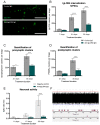Neurodegeneration Induced by Anti-IgLON5 Antibodies Studied in Induced Pluripotent Stem Cell-Derived Human Neurons
- PMID: 33917676
- PMCID: PMC8068068
- DOI: 10.3390/cells10040837
Neurodegeneration Induced by Anti-IgLON5 Antibodies Studied in Induced Pluripotent Stem Cell-Derived Human Neurons
Abstract
Anti-IgLON5 disease is a progressive neurological disorder associated with autoantibodies against a neuronal cell adhesion molecule, IgLON5. In human postmortem brain tissue, the neurodegeneration and accumulation of hyperphosphorylated tau (p-tau) are found. Whether IgLON5 antibodies induce neurodegeneration or neurodegeneration provokes an immune response causing inflammation and antibody formation remains to be elucidated. We investigated the effects of anti-IgLON5 antibodies on human neurons. Human neural stem cells were differentiated for 14-48 days and exposed from Days 9 to 14 (short-term) or Days 13 to 48 (long-term) to either (i) IgG from a patient with confirmed anti-IgLON5 antibodies or (ii) IgG from healthy controls. The electrical activity of neurons was quantified using multielectrode array assays. Cultures were immunostained for β-tubulin III and p-tau and counterstained with 4',6-Diamidine-2'-phenylindole dihydrochloride (DAPI). To study the impact on synapses, cultures were also immunostained for the synaptic proteins postsynaptic density protein 95 (PSD95) and synaptophysin. A lactate dehydrogenase release assay and nuclei morphology analysis were used to assess cell viability. Cultures exposed to anti-IgLON5 antibodies showed reduced neuronal spike rate and synaptic protein content, and the proportion of neurons with degenerative appearance including p-tau (T205)-positive neurons was higher when compared to cultures exposed to control IgG. In addition, cell death was increased in cultures exposed to anti-IgLON5 IgG for 21 days. In conclusion, pathological anti-IgLON5 antibodies induce neurodegenerative changes and cell death in human neurons. This supports the hypothesis that autoantibodies may induce the neurodegenerative changes found in patients with anti-IgLON5-mediated disease. Furthermore, this study highlights the potential use of stem cell-based in vitro models for investigations of antibody-mediated diseases. As anti-IgLON5 disease is heterogeneous, more studies with different IgLON5 antibody samples tested on human neurons are needed.
Keywords: IgLON5; autoimmune encephalitis; neurodegeneration; phosphorylated tau.
Conflict of interest statement
The authors declare no conflict of interest
Figures




References
-
- Sabater L., Gaig C., Gelpi E., Bataller L., Lewerenz J., Torres-Vega E., Contreras A., Giometto B., Compta Y., Embid C., et al. A novel non-rapid-eye movement and rapid-eye-movement parasomnia with sleep breathing disorder associated with antibodies to IgLON5: A case series, characterisation of the antigen, and post-mortem study. Lancet Neurol. 2014;13:575–586. doi: 10.1016/S1474-4422(14)70051-1. - DOI - PMC - PubMed
Publication types
MeSH terms
Substances
Grants and funding
LinkOut - more resources
Full Text Sources
Other Literature Sources
Research Materials

